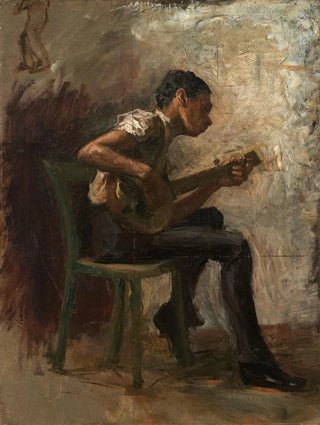Art print | Study for The Dance Lesson The Banjo Player - Thomas Eakins


View from behind

Frame (optional)
The artwork "Study for The Dance Lesson The Banjo Player" by Thomas Eakins is a true invitation to immerse oneself in the vibrant world of dance and music. This study, which precedes a more finished piece, reveals the genius of an artist capable of capturing the very essence of movement. Eakins, known for his realistic approach, manages here to transcend mere representation to offer an immersive experience. The dynamic of bodies in motion, the interaction between characters, and the palpable energy of the scene make this artwork a living testament to human passion and creativity. Through this art print, the viewer is transported to a suspended moment, where time seems to stand still, giving way to emotion.
Style and uniqueness of the work
The piece stands out for its unique style, blending realism and impressionism, characteristic of Eakins's period. The human figures, carefully studied, are depicted with anatomical precision that demonstrates the artist's expertise. Movements are captured in all their fluidity, revealing impressive technical mastery. Light plays a crucial role in this composition, illuminating faces and gestures, thus emphasizing the intensity of the moment. The color palette, both rich and subtle, creates a warm, almost tangible atmosphere. Every detail, from the banjo player's smile to the dancers' expressions, contributes to the harmony of the whole, making this study a piece of great emotional depth.
The artist and his influence
Thomas Eakins, an emblematic figure in American art history, knew how to mark his era with his innovative approach and dedication to realistic depictions of everyday life. Trained in Paris, he integrated European influences while remaining true to his American identity. Eakins often explored themes related to the human condition, science, and performance, and "Study for The Dance Lesson The Banjo Player" is no exception. The artist inspired many painters and sculptors, and his legacy endures through generations. His ability to capture the essence of movement and

Matte finish

View from behind

Frame (optional)
The artwork "Study for The Dance Lesson The Banjo Player" by Thomas Eakins is a true invitation to immerse oneself in the vibrant world of dance and music. This study, which precedes a more finished piece, reveals the genius of an artist capable of capturing the very essence of movement. Eakins, known for his realistic approach, manages here to transcend mere representation to offer an immersive experience. The dynamic of bodies in motion, the interaction between characters, and the palpable energy of the scene make this artwork a living testament to human passion and creativity. Through this art print, the viewer is transported to a suspended moment, where time seems to stand still, giving way to emotion.
Style and uniqueness of the work
The piece stands out for its unique style, blending realism and impressionism, characteristic of Eakins's period. The human figures, carefully studied, are depicted with anatomical precision that demonstrates the artist's expertise. Movements are captured in all their fluidity, revealing impressive technical mastery. Light plays a crucial role in this composition, illuminating faces and gestures, thus emphasizing the intensity of the moment. The color palette, both rich and subtle, creates a warm, almost tangible atmosphere. Every detail, from the banjo player's smile to the dancers' expressions, contributes to the harmony of the whole, making this study a piece of great emotional depth.
The artist and his influence
Thomas Eakins, an emblematic figure in American art history, knew how to mark his era with his innovative approach and dedication to realistic depictions of everyday life. Trained in Paris, he integrated European influences while remaining true to his American identity. Eakins often explored themes related to the human condition, science, and performance, and "Study for The Dance Lesson The Banjo Player" is no exception. The artist inspired many painters and sculptors, and his legacy endures through generations. His ability to capture the essence of movement and






